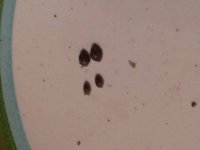I recently made a cross with KC Brains mango as the mother and Karma Ghostrider OG as the father.
While sorting through the seeds I noticed 2 distinct size differences.
When I purchased the Ghostrider I was surprised to see how tiny the seeds were.
Now sorting the cross I see tiny fully developed seeds and similarly colored seeds that are double in size. Both fully dark and mature.
So my question is this... is there anyone out there that has been able to pedictively sort phenotypes based on the characteristics of the seed. Color, size, shape, markings, etc.
I'm inclined to believe the tiny seeds would be ghostrider dominant...?
I know someone will say "grow them and find out" and I will. Just wondering if anyone has any input on this subject.
I thought it was surprising to see the size differences of the seeds assuming there was only one pollen source.
And go......
While sorting through the seeds I noticed 2 distinct size differences.
When I purchased the Ghostrider I was surprised to see how tiny the seeds were.
Now sorting the cross I see tiny fully developed seeds and similarly colored seeds that are double in size. Both fully dark and mature.
So my question is this... is there anyone out there that has been able to pedictively sort phenotypes based on the characteristics of the seed. Color, size, shape, markings, etc.
I'm inclined to believe the tiny seeds would be ghostrider dominant...?
I know someone will say "grow them and find out" and I will. Just wondering if anyone has any input on this subject.
I thought it was surprising to see the size differences of the seeds assuming there was only one pollen source.
And go......



